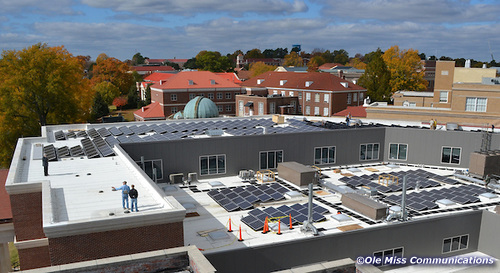Buildings and Campus Planning

Pictured: Solar panel array on the rooftop of the Center for Manufacturing Excellence.
According to the Global Alliance for Buildings and Construction, buildings account for more than one-quarter of greenhouse gas emissions. Constructing buildings in a more sustainable and efficient manner can help lessen these environmental effects. The University of Mississippi seeks to lessen environmental impacts related to campus development through longterm campus planning and sustainable architectural design standards.
Highlighted Initiatives
Campus Master Plan
The newly updated UM Master Plan guides future campus growth. The plan features principles of sustainability throughout, and seeks to promote a sustainable approach to campus development. The plan’s mobility framework prioritizes pedestrian, bicycle and transit use within central campus, and its landscape framework accounts for topography, hydrological patterns, natural systems and circulation routes on campus. View the plan here.
Sustainable Design
The university is home to seven Leadership in Energy and Environmental Design (LEED) certified buildings and multiple buildings that are constructed to sustainable design standards. LEED-certified buildings on campus include the Center for Manufacturing Excellence, the Robert Khayat Law Center, the Maynard Quimby Medicinal Plant Garden, Insight Park, the addition to Carrier Hall, Natural Products II and the Sally McDonnell Barksdale Honors College.
Highlighted Buildings:
Medicinal Plant Garden – In addition to low-flow fixtures, on-demand water heaters, Energy Star appliances and occupancy sensors, the Medicinal Plant Garden features a slant roof design that allows for rainwater to be captured into a 20,000 gallon tank and used daily to water plants in the greenhouse and shade house. The site also has concrete planters and wire mesh screens that allow for display of climbing plants and also create “green screens” which provide shading when grown in. The parking area consists of pervious pavement to reduce runoff, and the property is home to the UM Compost Site.
Center for Manufacturing Excellence – With more than 400 solar panels on the roof, CME is home to the largest roof-mounted solar power array in the state.
Insight Park – Among its many sustainable features, Insight Park was constructed with geothermal heating and cooling, low-flow plumbing fixtures, a reflective roof to reduce heat gain, a gearless elevator to reduce energy consumption, lighting sensors and energy efficient lighting throughout. Additionally, the building contains high recycled material content and features sunshades on the south-facing side to optimize daylighting and winter heat gain while reducing summer heat gain.
Robert C. Khayat Law Center – The law center was constructed with optimum orientation for daylighting and ventilation and has vertical window glazing to reduce solar heat gain, occupancy sensors and daylight sensor controls and low volume plumbing fixtures.
Thirteen percent of materials came from recycled content and 20 percent of materials were sourced from less than 500 miles away. Additionally, 94 percent of all construction waste was diverted from landfill.